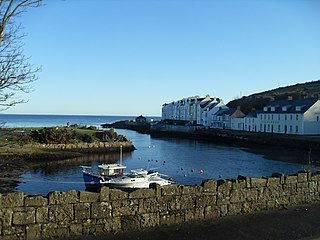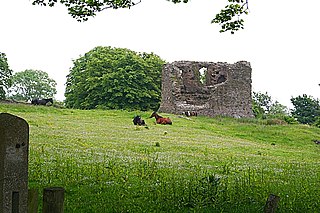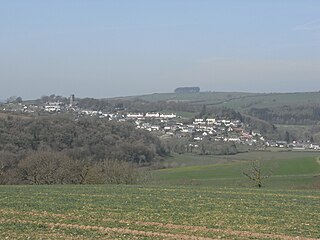
County Antrim is one of six counties that form Northern Ireland. Adjoined to the north-east shore of Lough Neagh, the county covers an area of 3,046 square kilometres (1,176 sq mi) and has a population of about 618,000. County Antrim has a population density of 203 people per square kilometre or 526 people per square mile. It is also one of the thirty-two traditional counties of Ireland, as well as part of the historic province of Ulster.

Oxfordshire is a county in South East England. The ceremonial county borders Warwickshire to the north-west, Northamptonshire to the north-east, Buckinghamshire to the east, Berkshire to the south, Wiltshire to the south-west and Gloucestershire to the west.

Ronald John McNeill, 1st Baron Cushendun PC was a British Conservative politician.

Milford is a village in Derbyshire, England, on the River Derwent, between Duffield and Belper on the A6 trunk road.

John Carr (1723–1807) was a prolific English architect. Best known for Buxton Crescent in Derbyshire and Harewood House in West Yorkshire, much of his work was in the Palladian style. In his day he was considered to be the leading architect in the north of England.

Gracehill is a village in County Antrim, Northern Ireland. It lies about 3 km from Ballymena and is in the townland of Ballykennedy. It is part of the Borough of Mid & East Antrim.

Cushendun is a small coastal village in County Antrim, Northern Ireland. It sits off the A2 coast road between Cushendall and Ballycastle. It has a sheltered harbour and lies at the mouth of the River Dun and Glendun, one of the nine Glens of Antrim. The Mull of Kintyre in Scotland is only about 15 miles away across the North Channel and can be seen easily on clear days. In the 2001 Census it had a population of 138 people. It is part of Causeway Coast and Glens district.

Armoy is a village and civil parish in County Antrim, Northern Ireland. It is 5.5 miles (9 km) southwest of Ballycastle and 8 miles (13 km) northeast of Ballymoney. According to an estimate in 2013 by the Northern Ireland Statistics and Research Agency it had a population of 1,122.
The Battle of Glentaisie, was an Irish battle fought in the north of Ulster on 2 May 1565. The result was a victory for Shane O'Neill over the Clan MacDonald of Dunnyveg. The conflict was a part of the political and military struggle, involving the English and occasionally the Scots, for control of northern Ireland. Although the MacDonalds were a Scottish family, based principally on the island of Islay in the Hebrides, they had long been associated with the Gaelic polity rather than the kingdom of Scotland.

Mileham is a village approximately midway between East Dereham and Fakenham in Mid Norfolk with a population of 563 people in 2011. The village sits astride the B1145 Kings Lynn to Mundesley road that dissects Mid Norfolk west to east. It is the old coaching road from Kings Lynn to Norwich and then on to Great Yarmouth.

Westow is a village and civil parish in the Ryedale district of the county of North Yorkshire, England. The village lies in the historic boundaries of the East Riding of Yorkshire. Westow is situated in the lee of Spy Hill, bordering the Howardian Hills Area of Outstanding Natural Beauty, 3 miles (4.8 km) from the A64 road linking Leeds to the East Coast, 5 miles (8 km) west of the market town Malton, and 15 miles (24 km) east from the city of York.

Causeway Coast and Glens is a local government district covering most of the northern part of Northern Ireland. It was created on 1 April 2015 by merging the Borough of Ballymoney, the Borough of Coleraine, the Borough of Limavady and the District of Moyle. The local authority is Causeway Coast and Glens Borough Council.

Clan Bissett is a Scottish clan. The clan is recognised by the Lord Lyon King of Arms but does not have a clan chief recognised by the Lord Lyon King of Arms, therefore the clan has no standing under Scots Law. Clan Bissett is considered an armigerous clan, meaning that it is considered to have had at one time a chief who possessed the chiefly arms; however, no one at present is in possession of such arms. The surname Bissett is also considered a sept of the Clan Fraser of Lovat.

Carra Castle or Castle Carra is a ruined castle, just north of Cushendun, County Antrim, Northern Ireland. It dates to around the early 14th century. The castle lies in a field near the coast and the harbour of Cushendun, known as Murlough Bay. The site had once been used during medieval times as a children's cemetery.

North Molton is a village, parish and former manor in North Devon, England. The population of the parish in 2001 was 1,047, decreasing to 721 in the 2011 census. An electoral ward with the same name also exists. The ward population at the census was 2,206. Bounded on the north east by the border with Somerset, it is the second largest parish in Devon, covering about 15,000 acres. Until the 18th century the village was an important centre of the woollen industry, and mining was also a significant employer in the parish until the 19th century.

Poltimore is a village, civil parish and former manor in East Devon district, in the county of Devon, England. It lies approximately 5 miles (8.0 km) northeast of Exeter. Poltimore consisted of 122 households and a population of 297 people during the 2011 census. It also includes the hamlet of Ratsloe.

Tomen yr Allt was a Medieval motte and bailey defensive castle near Llanfyllin in Powys, Wales.

The Knockando Woolmill is a historic woolmill in Moray, Scotland. Wool production has taken place at the site since at least the eighteenth century, and the surviving buildings house a number of pieces of historic machinery which are still in operation. It was designated a Category A listed building in 1995, still operates as a working mill, and is open to the public from April to September.

















